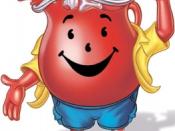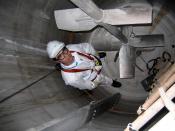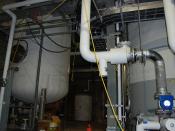A continuous stirred tank reactor (CSTR) is a continuous reactor that runs at a steady state. They are used most frequently with liquid phases, but can handle gas or solid reactions as well. No matter what the reactants are or the product is, all CSTR's have the same components. There is an inlet stream(s) that bring all of the reactants in at a particular rate. This stream(s) dumps into a large container; there is a shaft with a blade attached (stirrer) in the reactor that rotates around to mix the reactants. Finally there is an outlet stream, which the solution will exit from the reactor. The rates of the inlet and outlet streams must be carefully calculated in order to keep the volume inside the tank to stay the same. If this calculation is wrong, there is a great danger that the reactor will overflow, or not have enough solution in it.
(picture)
http://www.engin.umich.edu/~cre/
This picture was taken from a website generated by the University of Michigan, and is a very simple representation of what a CSTR looks like. The arrows represent the stream(s) responsible for bringing in reactants and removing products. The line in the middle represents the stirring unit. Note that this piece may not always be the same. There are different blades that attach to the shaft which cause different flow patterns within the tank. Tanks can be by themselves, or they can be joined together. The outlet stream leading into another CSTR allows this, and it helps ensure the contents of the solution are even more homogeneous. In a chemical reaction, it is very important that the ingredients are mixed well to avoid parts going through without being reacted.
The purpose of continuously stirred reactor is to keep reactants colliding steadily with each other during a...


